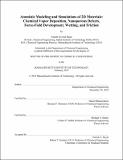| dc.contributor.advisor | Daniel Blankschtein and Michael S. Strano. | en_US |
| dc.contributor.author | Govind Rajan, Ananth. | en_US |
| dc.contributor.other | Massachusetts Institute of Technology. Department of Chemical Engineering. | en_US |
| dc.date.accessioned | 2019-07-15T20:36:18Z | |
| dc.date.available | 2019-07-15T20:36:18Z | |
| dc.date.copyright | 2019 | en_US |
| dc.date.issued | 2019 | en_US |
| dc.identifier.uri | https://hdl.handle.net/1721.1/121706 | |
| dc.description | This electronic version was submitted by the student author. The certified thesis is available in the Institute Archives and Special Collections. | en_US |
| dc.description | Thesis: Ph. D., Massachusetts Institute of Technology, Department of Chemical Engineering, 2019 | en_US |
| dc.description | Cataloged from student-submitted PDF version of thesis. | en_US |
| dc.description | Includes bibliographical references. | en_US |
| dc.description.abstract | Two-dimensional (2D) materials, such as, graphene, transition metal dichalcogenides (TMDs) (e.g., molybdenum disulfide (MoS₂)), and hexagonal boron nitride (hBN), have recently received considerable attention, due to their layer-number-dependent optoelectronic, mechanical, and barrier properties. However, physical understanding of the controlled synthesis and interfacial behavior of 2D materials is still lacking. In this thesis: First, I construct a generalized mechanistic model for the growth of TMD monolayers using chemical vapor deposition (CVD). Combining kinetic Monte Carlo (KMC) simulations and a chemical engineering transport model, I am able to predict the experimentally-observed shape and size evolution of the MoS₂ morphology inside a CVD reactor. Second, I address the challenge of solving the Isomer Cataloging Problem (ICP) for lattice nanopores in 2D materials. | en_US |
| dc.description.abstract | Combining electronic structure density functional theory (DFT) calculations, KMC simulations, and chemical graph theory, I generate a catalog of unique, most-probable isomers of 2D lattice nanopores, demonstrating remarkable agreement with experimental microscopy data for nanopores in graphene and hBN. Third, I study the photoluminescent properties of nanoporous defects in hBN by combining my solution to the ICP with extensive hybrid DFT calculations of electronic bandgaps. Doing so, I map the experimentally-observed emission energies to one or more defect shapes in hBN, thereby demonstrating structure-property relationships for defects in hBN, with implications for single-photon emission from hBN devices. Fourth, using molecular dynamics (MD) simulations, I show that electrostatic interactions play a negligible role in determining the contact angle and the friction coefficient of water on the MoS₂ basal plane. | en_US |
| dc.description.abstract | I show that other planes (e.g., the zigzag plane) are polar with respect to interactions with water, thereby illustrating the role of edge effects in MoS₂. Fifth, I combine lattice dynamics calculations with DFT-based MD simulations to develop a force field for hBN for use in mechanical and interfacial applications. The force field predicts the crystal structure, elastic constants, and phonon dispersion relation of hBN with good accuracy, and demonstrates remarkable agreement with the interlayer and water-hBN binding energies predicted by advanced ab initio calculations. Finally, using MD simulations, I study the wetting and frictional properties of hBN by three different liquids of varying degrees of polarity. I infer that electrostatic interactions affect the frictional properties of various liquids in contact with hBN to different extents, and propose the mean-squared total lateral force as a physical metric to rationalize this observation. | en_US |
| dc.description.abstract | This finding implies that liquids with lower wettability can exhibit higher friction on hBN surfaces. In conclusion, the theoretical and simulation methods developed and applied in this thesis should inform the synthesis of 2D materials, and their use in various applications, such as, optoelectronic devices, mechanical composites, and membranes for gas separation and water desalination. | en_US |
| dc.description.statementofresponsibility | by Ananth Govind Rajan. | en_US |
| dc.format.extent | 426 pages | en_US |
| dc.language.iso | eng | en_US |
| dc.publisher | Massachusetts Institute of Technology | en_US |
| dc.rights | MIT theses are protected by copyright. They may be viewed, downloaded, or printed from this source but further reproduction or distribution in any format is prohibited without written permission. | en_US |
| dc.rights.uri | http://dspace.mit.edu/handle/1721.1/7582 | en_US |
| dc.subject | Chemical Engineering. | en_US |
| dc.title | Atomistic modeling and simulations of 2D materials : chemical vapor deposition, nanoporous defects, force-field development, wetting, and friction | en_US |
| dc.type | Thesis | en_US |
| dc.description.degree | Ph. D. | en_US |
| dc.contributor.department | Massachusetts Institute of Technology. Department of Chemical Engineering | en_US |
| dc.identifier.oclc | 1103318612 | en_US |
| dc.description.collection | Ph.D. Massachusetts Institute of Technology, Department of Chemical Engineering | en_US |
| dspace.imported | 2019-07-15T20:36:16Z | en_US |
| mit.thesis.degree | Doctoral | en_US |
| mit.thesis.department | ChemEng | en_US |
